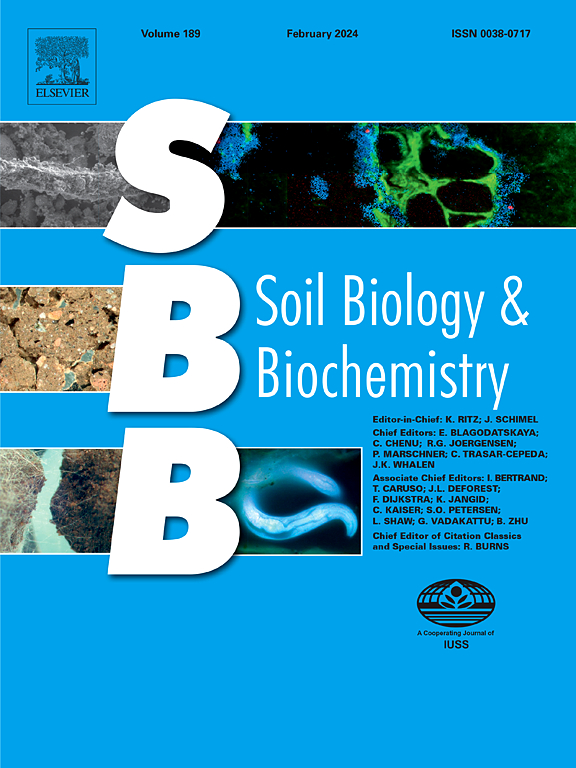Evidence of the need for crop-specific N2O emission factors
IF 9.8
1区 农林科学
Q1 SOIL SCIENCE
引用次数: 0
Abstract
Crop residues are an important source of N for subsequent crops and contribute to cropping system nitrous oxide (N2O) emissions. Oilseed residues, particularly canola (Brassica napus L.), can instigate higher N2O emissions compared to pulse and wheat crop residues but the reason for this disproportionate emission response is unknown. To determine the quantity and source of N2O emissions, we conducted an incubation experiment (84 d) using 15N and 13C labelled residues of canola, wheat, flax, pea and investigated key N-cycling gene abundances, microbial abundance and community structure using PLFA and soil C and N dynamics. Residue addition of all types significantly increased microbial abundance and abundances of denitrification and nitrification genes. Canola residue resulted in significantly greater nosZI abundance. Lower incorporation of canola residue 13C into PLFA and higher 13CO2 emissions suggests that canola residue C was used less efficiently (i.e., less for growth and more for respiration), depleting O2 and stimulating denitrification. The magnitude of N2O emission from residue-amended soils was significantly higher (p < 0.05) than the unamended control soil and differed with residue type: canola > pea = wheat > flax > control. The canola residue emission factor was 1.56% of residue N – significantly higher than that of wheat (0.99%), pea (0.95%) and flax (0.18%). This higher canola emission factor resulted from greater residue-derived (1.47%) N2O as well as residue-induced (0.65%) soil emissions. The combined use of stable isotope tracing of 15N2O and 13CO2 and microbial characterization quantified differences in residue-derived N2O emissions from common crops that were linked to differences in microbial abundance, community structure and activity.
需要特定作物一氧化二氮排放系数的证据
作物残茬是后续作物氮的重要来源,并有助于种植系统的氧化亚氮(N2O)排放。油籽残余物,特别是油菜(Brassica napus L.),与脉冲和小麦作物残余物相比,可以激发更高的N2O排放,但这种不成比例的排放响应的原因尚不清楚。为了确定N2O排放的数量和来源,我们利用15N和13C标记的油菜籽、小麦、亚麻和豌豆的残留物进行了84 d的培养实验,并利用PLFA和土壤C和N动态研究了关键N循环基因丰度、微生物丰度和群落结构。添加各类残渣均显著提高了微生物丰度及反硝化和硝化基因丰度。油菜籽渣导致nosZI丰度显著增加。菜籽油残渣13C在PLFA中的含量较低,13CO2排放量较高,表明菜籽油残渣C的利用效率较低(即用于生长的较少,用于呼吸的较多),从而消耗氧气并刺激反硝化作用。残渣改良土壤N2O排放量显著增加(p <;0.05),且不同残留类型差异显著:油菜籽;豌豆=小麦>;亚麻比;控制。油菜残氮排放因子为残氮排放因子的1.56%,显著高于小麦(0.99%)、豌豆(0.95%)和亚麻(0.18%)。油菜籽排放因子的增加是由于土壤中残渣源N2O排放量(1.47%)和残渣源N2O排放量(0.65%)增加所致。利用15N2O和13CO2的稳定同位素示踪和微生物特征相结合,量化了普通作物残茬N2O排放的差异,这些差异与微生物丰度、群落结构和活性的差异有关。
本文章由计算机程序翻译,如有差异,请以英文原文为准。
求助全文
约1分钟内获得全文
求助全文
来源期刊

Soil Biology & Biochemistry
农林科学-土壤科学
CiteScore
16.90
自引率
9.30%
发文量
312
审稿时长
49 days
期刊介绍:
Soil Biology & Biochemistry publishes original research articles of international significance focusing on biological processes in soil and their applications to soil and environmental quality. Major topics include the ecology and biochemical processes of soil organisms, their effects on the environment, and interactions with plants. The journal also welcomes state-of-the-art reviews and discussions on contemporary research in soil biology and biochemistry.
 求助内容:
求助内容: 应助结果提醒方式:
应助结果提醒方式:


